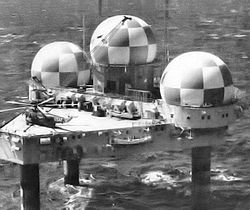
A radome is a structural, weatherproof enclosure that protects a radar antenna. The radome is constructed of material transparent to radio waves. Radomes protect the antenna from weather and conceal antenna electronic equipment from view. They also protect nearby personnel from being accidentally struck by quickly rotating antennas.
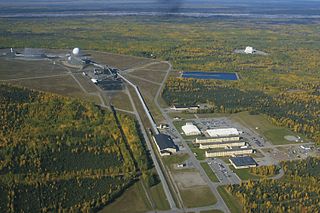
Clear Space Force Station is a United States Space Force radar station for detecting incoming ICBMs and submarine-launched ballistic missiles to NORAD's command center and to provide Space Surveillance data to the United States Space Force. Clear's AN/FPS-123 Upgraded Early Warning Radar is part of the Solid State Phased Array Radar System (SSPARS) which also includes those at Beale AFB, Cape Cod Space Force Station, RAF Fylingdales and Thule Site J. The "historic property" was one of the Alaska World War II Army Airfields and later a Cold War BMEWS site providing NORAD data to Colorado's BMEWS Central Computer and Display Facility (CC&DF).
The AN/FPS-35 frequency diversity radar was a long range search radar used in the early 1960s. It was one of the largest air defense radars ever produced, with its antenna and supporting structure mounted on one of the largest rolling-element bearings in the world.
Montauk Air Force Station was a US military base at Montauk Point on the eastern tip of Long Island, New York. It was decommissioned in 1981 and is now owned by the New York State Office of Parks, Recreation and Historic Preservation as Camp Hero State Park.
Mount Hebo Air Force Station is a closed United States Air Force General Surveillance Radar station. It is located 5.2 miles (8.4 km) east-southeast of Hebo, Oregon, located at the top of 3,154-foot (961 m) Mount Hebo. It was closed in 1980.

North Truro Air Force Station (AFS) is a closed United States Air Force General Surveillance Radar station. It is located 2.2 mi (3.5 km) east of North Truro, Massachusetts.

Texas Tower 2 was a former United States Air Force Texas Tower General Surveillance Radar station, first operational in 1955. It was located 110 miles (180 km) east of Cape Cod, Massachusetts, in 56 feet (17 m). The tower was closed in 1963 and dismantled.
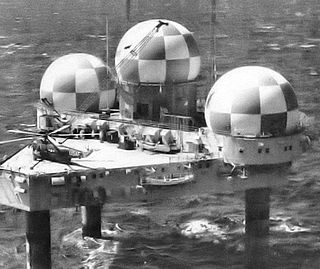
Texas Tower 3 was a former United States Air Force Texas Tower General Surveillance Radar station, first operational in November 1956. The radar station was 50 miles (80 km) southeast of the coast of Nantucket, Massachusetts, in 80 feet of water. The tower was closed in 1963 and dismantled.

Texas Tower 4 was a United States Air Force Texas Tower General Surveillance Radar station, located 63 miles (101 km) south-southeast off the coast of Long Island, New York in 185 feet (56 m) of water. Hurricane Donna struck the tower in September 1960, seriously damaging it. The tower was the site of an accident and was destroyed by a winter storm on January 15, 1961. None of the twenty-eight airmen and civilian contractors who were manning the station survived.
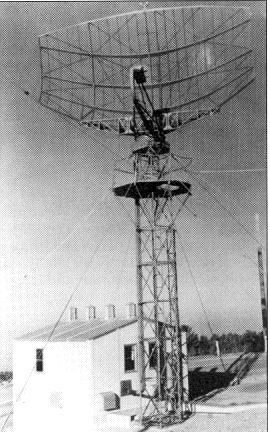
The AN/FPS-8 Radar was a Medium-Range Search Radar used by the United States Air Force Air Defense Command.
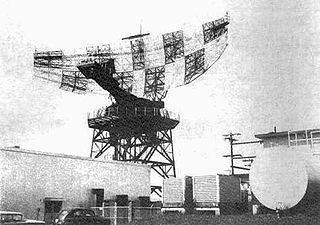
The AN/FPS-24 Radar was a long range early warning radar used by the United States Air Force Air Defense Command. It used a two-frequency signal in order to avoid fluctuation loss, which causes signals on single-frequency radars to fade in and out as the target moves. Reducing this effect results in a much steadier signal.
The Avco AN/FPS-26 Radar was an Air Defense Command height finder radar developed in the Frequency Diversity Program with a tunable 3-cavity power klystron for electronic counter-countermeasures (e.g. to counter jamming). Accepted by the Rome Air Development Center on 20 January 1960 for use at SAGE radar stations, the AN/FPS-26 processed height-finder requests (e.g., from Air Defense Direction Centers) by positioning to the azimuth of a target aircraft using a high-pressure hydraulic drive, then "nodding" in either a default automatic mode or by operator command. The inflatable radome required a minimum pressure to prevent contact with the antenna which would result in damage to both (technicians accessed the antenna deck via an air lock.) To maintain high dielectric strength, the waveguide was pressurized with sulfur hexafluoride (SF6), which technicians were warned would produce deadly fluorine if waveguide arcing occurred.

Cape Charles Air Force Station is a closed United States Air Force General Surveillance Radar station. It is located 3.6 miles (5.8 km) south of Townsend, Virginia. It was closed in 1981. From 1941 to 1948 it was Fort John Custis of the United States Army Coast Artillery Corps. Since 1984 the site has been in the Eastern Shore of Virginia National Wildlife Refuge. For this article's purposes the term "Fort John Custis" includes the nearby Fisherman Island.
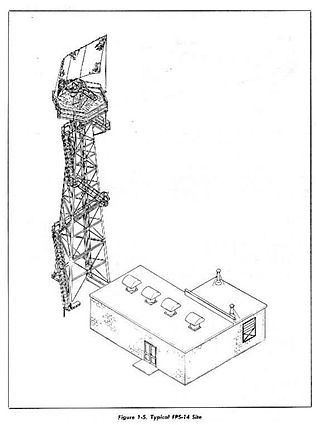
The AN/FPS-14 was a medium-range search Radar used by the United States Air Force Air Defense Command.
The AN/FPS-18 was a medium-range search Radar used by the United States Air Force Air Defense Command.
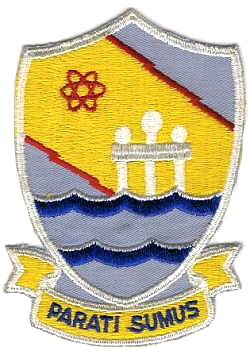
The 4604th Support Squadron (Texas Towers) is an inactive United States Air Force unit. It was last assigned to the 26th Air Division, Aerospace Defense Command, stationed at Otis Air Force Base, Massachusetts. It was inactivated on 1 July 1963.

The 14th Test Squadron is a United States Air Force unit located at Schriever Air Force Base, Colorado. It is an Air Force Reserve unit that augments the 17th Test Squadron. The squadron is responsible for testing and evaluating space systems and associated support equipment. The unit was originally established in 1972 as the 14th Missile Warning Squadron. The missile warning squadron was an active duty unit that operated early warning radars at eight locations around the United States until it was inactivated in 1980. The squadron was reactivated and given its current space test mission in 2000.
An Arctic Tower is a 20 ft diameter cylindrical radar station structure of the AN/GPA-33 Radar Set Group for protecting a USAF radar's antenna and electronic cabinets. Designed for low temperatures and strong winds, the 25 ft high tower's top platform supported an antenna group and a 20 ft high CW-313/FPS radome which was "capable of withstanding two inches of ice" and winds of 109 knots. The 25,000 lb Arctic Tower was designed for supporting Radar Set AN//TPS-10D (AN/FPS-4) or Radar Set AN/TPS-1D, and could support other systems up to a load of 100psf on the 20 foot diameter platform, the interior 2nd floor, or the ground floor. In addition to protecting a radar system, the tower housed other AN/GPA-33 equipment such as the Radome Interior Control Group (OA-709/GPA-33) which included

A radar tower is a tower whose function is to support a radar facility, usually a local airport surveillance radar, and hence often at or in the vicinity of an airport or a military air base. The antenna is often continually rotating. In addition, radar towers are used for the installation and operation of search and height finder radars at military radar stations, where the mission is to support air defense missions. These missions were characterized as Aircraft Control & Warning (AC&W), or Long Range Surveillance in support of the Semi-Automatic Ground Environment (SAGE).

The Saugatuck Gap Filler Annex is a decommissioned air defense radar installation previously of the United States Air Force. It served in the vast Cold War era Semi-Automatic Ground Environment (SAGE) air defense system. Of the hundreds of SAGE radars, Saugatuck's is one of, perhaps, two that remain nearly completely intact.
